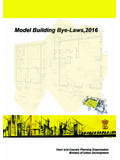Transcription of MAINTENANCE SCHEDULE, POST STORAGE TREATMENT …
1 MANUAL ON rooftop rainwater harvesting SYSTEMS IN SCHOOLS MAINTENANCE SCHEDULE, POST STORAGE TREATMENT PROCEDURE AND PRECAUTIONS PDF Created with deskPDF PDF Writer - Trial :: Introduction: The Government of Karnataka through the Rural Development and Panchayath Raj department has launched a rooftop rainwater harvesting programme for 23,683 schools all across the state. The schools have been selected on the basis that they do not have any source of drinking water currently. The programme seeks to provide each student with litres of drinking water through harvesting rainwater from rooftops of the schools. The construction component of the programme is being implemented by the Engineering Department of the various Zilla Panchayath or by the District Nirmithi Kendra.
2 What is rainwater harvesting ? It is the process of collecting and storing water for future productive use. What is rooftop rainwater harvesting ? Since it is quite easy to collect rainwater falling on roofs, rooftop rainwater harvesting is the process of collecting rainwater falling on rooftops in a tank or sump for future productive use. Why rooftop rainwater harvesting in schools? Many schools presently do not have a reliable source of water for drinking and other use. The school rooftop rainwater harvesting system seeks to provide a source of water for all purpose such as toilet flushing, cooking, washing hands and feet before eating and after toilet use, hygiene and finally if the rainwater is treated well for drinking purpose. Fig 1: rainwater can be used for the cooking of meals for students (Bisi Oota) This is especially important in areas where there is Fluoride, Nitrate, iron or salt in the groundwater and therefore it is unfit for consumption.
3 In these places the rainwater harvesting tank can provide mineral free water for consumption. PDF Created with deskPDF PDF Writer - Trial :: Fig 2: Children need safe drinking water in schools How much rainwater can be collected? This depends on the rooftop area, the size of the tank and the rainfall at that place. For example in a place where it rains 500 mm and the roof area is 100 square meters, the rainwater falling on the roof is 50,000 liters. Some amount of it will be absorbed by the roof and some amount will be lost in the collection process. If we assume 80% can be collected then 40,000 liters of rainwater is available for collection. Depending on the size of the rainwater tank and the distribution of rainfall even a 3000 liter tank may be sufficient to collect all this 40,000 liters of rainwater .
4 We must however keep on using the rainwater in the tank and not wait for summer to use it. By painting an information board , and keeping a small rain gauge in the school , a good school can involve students in monitoring rainfall, total rain in a year, water collected in the rainwater tank and teach them how to ensure good MAINTENANCE of the system . Fig 3: A good school will involve students and teachers in monitoring the rainwater system PDF Created with deskPDF PDF Writer - Trial :: COMPONENTS What are the parts of the roof top rainwater harvesting system ? ROOF The existing roof is made use of to collect rainwater . Since rainwater is pure as it falls from the sky it is necessary that the roof be kept clean for it to remain pure when it is collected. This means the roof will need to be swept and cleaned daily during the rainy season in the district.
5 Fig 4: & 5: A roof full of leaves, this should be cleaned daily A sloping roof should be cleaned by adults This should be carefully done by an adult (never by children unless it is accessible and safe) equipped with the necessary implements such as a ladder, broom and a brush if necessary. Some schools will have shady trees to cover the roof. However leaves falling from the roof will cause blockage in the gutters and pipes. The leaves can also color the water and cause it to decompose and smell. Therefore, roofs should invariably be completely cleaned of all leaves, dust, bird droppings etc. using a broom. Water should only be used if necessary as most times a dry sweeping with a broom will be enough. When cleaning the roof with water be careful to keep the first rain separator open so as not to allow the dirt to come into the filter and the tank.
6 PVC GUTTERS: The gutters of PVC collect the rainwater from the roof and transfer it to the filter. On sloping roofs, PVC gutters can pick up leaves, dust, small twigs and other organic matter. The gutters need to be cleaned regularly at least weekly once. During the rainy season the PVC gutters should be inspected and cleaned daily. Fig 6: A clean PVC gutter to catch every drop of rain PDF Created with deskPDF PDF Writer - Trial :: The gutters are fixed to the roof or to the walls with clamps. The clamps hold the gutter or pipes to the wall or to the roof firmly and allow a small slope in the system to enable water to flow in one direction. The clamps sometimes may come off due to various reasons. The clamps should be fixed immediately whenever it is seen to be loose or when it has come off.
7 Fig 7: A well supported horizontal pipe for a flat roof At all times the PVC gutters or pipes should slope in the direction of the STORAGE tank and not away from it. The PVC gutters should always have an end cap at the end where rainwater begins to flow in the direction of the tank. Fig 8: End cap for the gutter DOWNPIPES: PVC down pipes brings the water from the rainwater gutters or pipes vertically down. They should invariably be clamped firmly to the wall and should never be loosely fixed. Always check that the down pipe is firmly fixed and if necessary replace or tighten the clamp whenever necessary. FIRST RAIN SEPARATOR: The first rain separator or a washout pipe as it is called, has a valve or an end cap to allow the first little amount of rainwater to be collected PDF Created with deskPDF PDF Writer - Trial :: This has most of the dust and dirt in it.
8 The first rain separator also is used when the roof is being cleaned or when rainwater is NOT to be collected. It is important to ensure that the first rain separator is always kept in the closed position and never left open. After every rain it should be opened carefully and the waste water allowed to flow out. The pipe should then be cleaned and the valve or the end cap closed. Sometimes the first rain separator can get jammed due to the dirt or dust in it. In such a situation the valve or the end cap should be carefully replaced by a good plumber. Fig 9 & 10: A good first rain separator with end cap on the wall Gate valve can also be used LEAF TRAP: Where the roof of a school has lots of leaves falling from a tree or trees a conical leaf trap can be placed in the vertical down pipe.
9 This has a mesh on top. The mesh prevents small leaves, twigs and other material from entering the pipe and blocking it or choking the filter. The material collected on the leaf trap if any must be removed at regular intervals and daily during the rainy season. FILTER: A gravel, sand and netlon mesh filter is designed and placed on top of the STORAGE tank. This filter is very important in keeping the rainwater in the STORAGE tank clean. It removes silt, dust, leaves and other organic matter from entering the STORAGE tank. The filter media should be cleaned daily after every rainfall event. Clogged filters prevent rainwater from easily entering the STORAGE tank and the filter may overflow. The sand or gravel media should be taken out and washed before it is replaced in the filter.
10 PDF Created with deskPDF PDF Writer - Trial :: Fig 11: A good filter with mesh and gravel on top STORAGE TANK: The rainwater STORAGE tank collects all the filtered rainwater and keeps it for future use. The STORAGE tank is made above the ground and on a platform. It can also be an underground sump in some cases. The tank is invariably painted white on the outside. This is done to keep the water inside cool and prevent the growth of bacteria. Every year the tank must be white washed neatly. Fig 12: A clean STORAGE tank on a platform painted white on the outside The tank also will be sealed from the top either with Cuddapah slabs or concrete slabs or any local stone. It must be ensured that the top cover is permanent and always fully covered.

